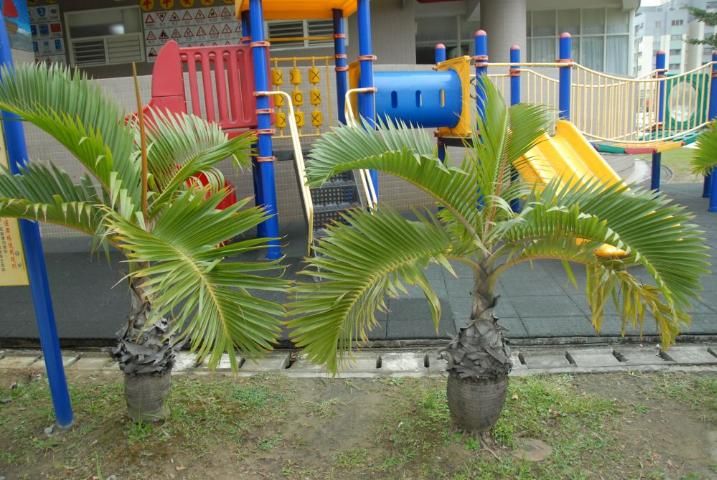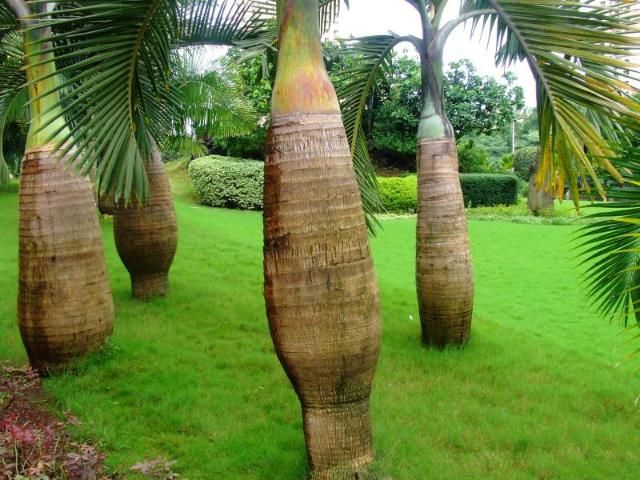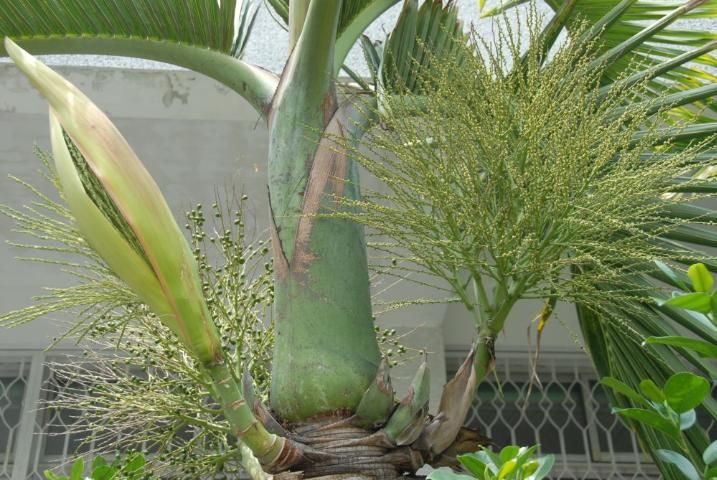Family
Arecaceae, palm family.
Genus
Hyophorbe is a combination of two Greek words: hyo meaning "pig, hog" and phorb meaning "feed, fodder." The name of the genus is thought to come from the use of its fruits for pig fodder.
Species
The species name lagenicaulis also is a combination of two Greek words: lagen meaning "a flask" and caulis meaning "a stem," in reference to the bottle-shaped trunk of this palm.
Common Name
Bottle Palm
The common name of this palm comes from the shape of its stem, which resembles the shape of a bottle; bulbous at its base and slender near the top.
Description
This palm is endemic to the Mascarene Islands, which occur east of Madagascar in the Indian Ocean. It naturally inhabits well-drained sandy soils of upland forests and coastal savannas. In America, it can grow in climates found in south Florida, extreme southern California, and the Hawaiian Islands. This tree is slow growing but can reach heights that range from 12 to 20 feet. It grows best in full sunlight but can tolerate moderate shade. The pinnately compound leaves or fronds can grow to 12 feet long and are attached to a 10-inch petiole or stem. Its slender, lance-shaped leaflets are dark green, approximately 2 feet long, and grow opposite from one another to form a "V" shape on the rachis or middle of the frond. The trunk is smooth, light gray to almost white, and when young has a noticeably swollen base that becomes less pronounced and elongated as it matures. On top of the trunk sits a bright green crownshaft (from which the fronds emerge) that has a smooth, waxy surface and can reach 2 to 3 feet in height. Heavily branched flower inflorescences encircle the trunk just below the crownshaft and can reach lengths of 3 feet. Male and female flowers occur on the same inflorescence and are white or cream colored. Fruits are one inch in diameter and turn from green to black as they ripen.

Credit: plj.johnny, CC BY-NC-SA 2.0

Credit: Shubhada Nikharge, CC BY-NC-SA 2.0

Credit: plj.johnny, CC BY-NC-SA 2.0
Applications
Horticultural
The shape of this palm's trunk, with its bulbous base that tapers to a slender cylinder, is in itself eye-catching. It can be planted singly to highlight its physical characteristics or in groups of three or more. It grows best in hot conditions but requires additional irrigation during drier times, and freezing temperatures will most likely kill this palm. In Florida, it is recommended that additional potassium be applied for optimal growth and health. Bottle palm can do well in indoor situations as long as it has ample light and room to grow. Fortunately, this palm is cultivated and planted worldwide; it is critically endangered almost to the point of extinction in its natural range.
References
Borror, D. J. 1988. Dictionary of root words and combining forms (2nd ed.). Mountain View, CA: Mayfield Publishing Company.
Floridata.com. 1999. Hyophorbe lagenicaulis, Retrieved from http://www.floridata.com/ref/H/hyop_lag.cfm
Meerow, A. W. 2004. Betrock's guide to landscape palms (9th ed.). Hollywood, FL: Betrock Information Systems.
Riffle, R. L. and P. Craft. 2003. An encyclopedia of cultivated palms. Portland, OR: Timber Press, Inc.